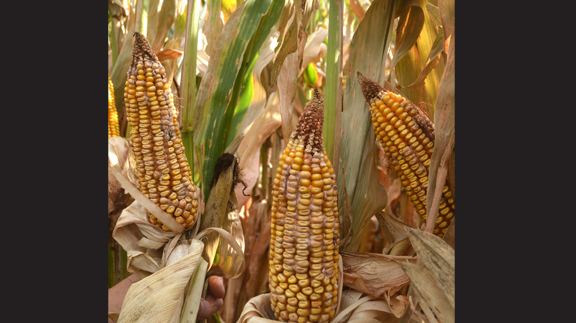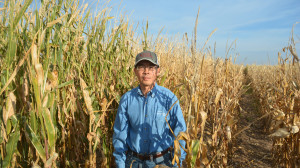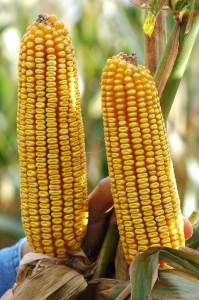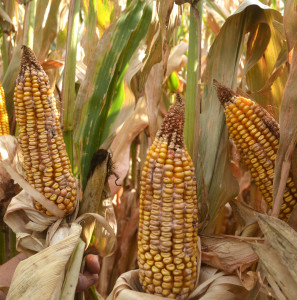Farm & Ranch
AgriLife research scientist: Delay corn planting in stressful years

By: Kay Ledbetter
Writer: Kay Ledbetter, 806-677-5608, [email protected]
Contact: Dr. Qingwu Xue, 806-354-5803, [email protected]
AMARILLO – A wet spring filled with hail storms brought challenges to this year’s corn crop, some that a Texas A&M AgriLife Research scientist said could have been avoided if planting was delayed by a couple weeks or more.
Dr. Qingwu Xue, AgriLife Research plant physiologist in Amarillo, said he did not intentionally start out emphasizing planting dates on his corn studies. But what he saw on his hybrid trials near Bushland showed what a tremendous difference the planting date can make in a stressful year.
Xue said he generally plants anywhere from three to five different corn trials on the AgriLife Research farms around Bushland, including some comparing hybrid production under different irrigation rates and others for chemical efficacy.
“It seems every year the Texas High Plains presents its own unique challenges,” Xue said. “Some years it is drought, but this year was a historically wet year that included hail storms and insect and disease problems.”
He planted corn on four dates this year. The first two planting dates were May 18 and June 3. A hailstorm with severe wind struck on June 14 and caused losses of up to 60 percent of the stand on the May 18 planting.
“But because the growing point of the June 3 planting was still below ground, corn plants simply resprouted and we lost very few plants,” Xue said.
The third and fourth planting dates were June 17 and June 19. The June 19 planting was a replant of some of the May 18 trials that were severely hail damaged, he said.
“Two hail storms in early July caused some damage to the corn planted on June 3, however there was little to no stand loss for corn planted on June 17 and June 19,” Xue said, adding the last two plantings produced the best corn they saw this year in their trials.
“So planting dates really did make a difference,” he said. “If you get the hail damage in the early vegetative stage, you don’t get as much damage to yields, but if the plant is already big, you get greater stand damage.”
Additionally, the side-by-side plots of corn suffered various insect attacks, primarily grasshoppers, as well as earworms and fungal diseases, Xue said.
He said among his trials was a comparison of the different hybrids for their protection against ear damage from disease and insects.
“Producers need to make sure the hybrid they are buying has a good ear protection trait included in it, because we saw a clear difference between hybrids this year with all of the heavy insect and disease pressure,” he said.
“What we learned this year is just don’t rush to plant your corn too early,” he said. “The traditional planting dates in this area are late April or early May. However, corn we planted on June 19 is still the best corn we got this year.
“I would say if you would delay your planting date, you can avoid some of the heavy hail damage that can accompany spring storms.”
Xue said, however, that producers who decide to delay their planting date should be mindful of the hybrid they plant.
“You don’t want to use the long-season hybrids; 120-day corn is probably too risky with delayed planting,” he said. “If your corn is under full irrigation or well-watered, the longer-season hybrids have the greatest yield potential.
“But in years when the weather is drier and you only can use limited irrigation or you are delaying planting, you should use a mid-season or short-season hybrid and it will give you more flexibility in your operation.”
-30-
Find more stories, photos, videos and audio at http://today.agrilife.org
Farm & Ranch
Managing Show Cattle Through The Winter

By Heather Welper
Husband and wife duo, Heather and Calvin Welper, are the Co-Owners and Operators or Two C Livestock, located in Valley View, Texas.
The pair’s operation has a show cattle focus where they raise and sell purebred heifers of all breeds and club calf Hereford steers.
When it comes to show cattle, the Welpers know a thing or two including how to prepare for the cold winter months and the Texas major show season run.
To read more, pick up a copy of the November edition of North Texas Farm & Ranch magazine, available digitally and in print. To subscribe by mail, call 940-872-5922.

Farm & Ranch
Double M Ranch & Rescue

By Hannah Claxton, Editor
As the sun rises each day, so do the dozens of mouths that Meghan McGovern is responsible for getting fed. Rather than the sounds of a rooster crowing, McGovern hears the bellows and bleats of a variety of exotic deer, the chortle of kangaroos, the grunts of water buffaloes, and the chirps of a lemur.
Nestled against the banks of the Red River, the Double M Ranch and Rescue, with its high game fences and deer sprinkling the landscape,s its in stark contrast to the surrounding ranches.
“Having deer is kind of like eating potato chips- you can never actually have just one,” said McGovern with a laugh.
McGovern has several herds to take care of- fallow deer, axis deer, water buffalo, goats, and bison. In smaller numbers, there’s also a few kangaroos, a lemur, a potbelly pig, a pair of zebras, a watusi, and a few horses.
To read more, pick up a copy of the November edition of North Texas Farm & Ranch magazine, available digitally and in print. To subscribe by mail, call 940-872-5922.

Farm & Ranch
Acorn Toxicity

By Barry Whitworth, DVM, MPH
With the prolonged drought, most pastures in Oklahoma end up in poor condition. With the lack of available forage, animals may go in search of alternative foods.
If oak trees are in the pastures, acorns may be a favorite meal for some livestock in the fall. This may result in oak poisoning.
Oak leaves, twigs, buds, and acorns may be toxic to some animals when consumed.
To read more, pick up a copy of the November edition of North Texas Farm & Ranch magazine, available digitally and in print. To subscribe by mail, call 940-872-5922.

-

 Country Lifestyles2 years ago
Country Lifestyles2 years agoScott & Stacey Schumacher: A Growth Mindset
-

 Country Lifestyles8 years ago
Country Lifestyles8 years agoStyle Your Profile – What your style cowboy hat says about you and new trends in 2017
-

 HOME8 years ago
HOME8 years agoGrazing North Texas – Wilman Lovegrass
-

 Outdoor10 years ago
Outdoor10 years agoButtercup or Primrose?
-

 Country Lifestyles5 years ago
Country Lifestyles5 years agoAmber Crawford, Breakaway Roper
-

 Country Lifestyles9 years ago
Country Lifestyles9 years agoJune 2016 Profile – The man behind the mic: Bob Tallman
-

 Equine1 year ago
Equine1 year agoThe Will to Win
-

 Country Lifestyles8 years ago
Country Lifestyles8 years agoDecember 2016 Profile, Rusty Riddle – The Riddle Way







